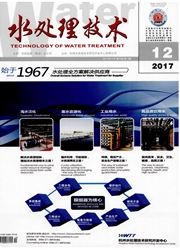

 中文摘要:
中文摘要:
利用原牡蛎壳、破碎牡蛎壳、塑料球分别为填料的曝气生物滤池(BAF)对城市生活污水进行处理,考察牡蛎壳作为BAF填料的可行性。结果表明,在COD和NH3-N去除方面,牡蛎壳填料要优于塑料球填料,原牡蛎壳、破碎牡蛎壳、塑料球填料BAF对COD的平均去除率分别为78.1%、77.8%、74.5%;当HRT大于4h时,3种填料BAF对NH3-N的去除率分别为97.7%、97.3%和93%;HRT为2h时,对NH3-N去除率分别为55.5%、89.8%、35.1%;3种填料BAF对TP的去除主要通过磷作为微生物繁殖生长的营养成分而被去除;当HRT大于4h,由于牡蛎壳可中和NH3-N硝化过程产生的H^+,2种牡蛎壳填料BAF出水的pH均高于塑料球填料BAF出水的pH,这也是牡蛎壳填料BAF对NH3-N具有较高去除率的原因。牡蛎壳可以作为BAF的填料,且在COD、NH3-N的去除率以及出水pH方面优于塑料球填料。
 英文摘要:
英文摘要:
Raw oyster shell, fragmentized oyster shell and plastic ball as medium were applied for the biological aerated filters (BAF) to treat municipal wastewater. The results show that remove COD, NH3-N, TP from municipal wastewater in three lab scale upflow BAF, the effluent pH of three BAF were also investigated. The results indicated that oyster shell medium was superior to plastic ball medium on the COD and NH3-N removal. The COD removal efficiencies of raw oyster shell BAF, fragmentized oyster shell BAF and plastic ball BAF effiuents were 78.1 %, 77.8% and 74.5%, respectively. When HRT was longer than 4 h, NH3-N removal efficiencies were 97.7%,97.3% and 93%, respectively. NH3-N removal efficiencies were 55.5%,89.8% and 35.1 % for HRT of2 h, respectively. TP was removed mainly as the nutrition consumption for microorganism. Effiuent pH of two oyster shell BAFs was higher than plastic ball BAF, mainly due to its buffer ability to neutralize W produced during NH3-N nitrification, this was also the main reason of oyster shell BAF had higher NH3-N removal efficiency. The study results indicated that oyster shell can be a good medium for BAF.
 同期刊论文项目
同期刊论文项目
 同项目期刊论文
同项目期刊论文
 Adsorption of nanoactive cerium hydroxide for arsenic removal:effects of pH, temperature, and co-occ
Adsorption of nanoactive cerium hydroxide for arsenic removal:effects of pH, temperature, and co-occ Electrochemical degradation of methylene blue using electrodes of stainless steel net coated with si
Electrochemical degradation of methylene blue using electrodes of stainless steel net coated with si 期刊信息
期刊信息
